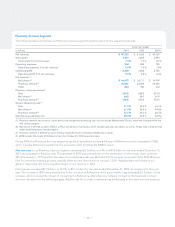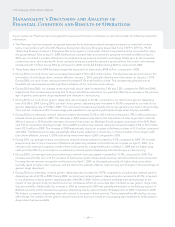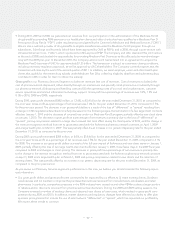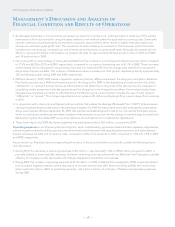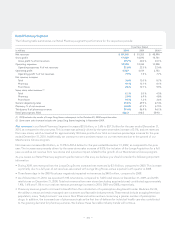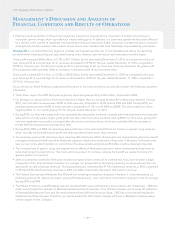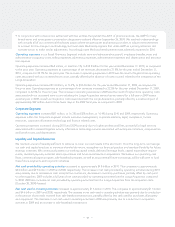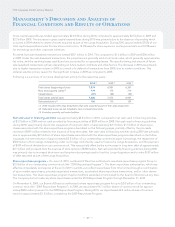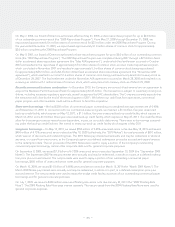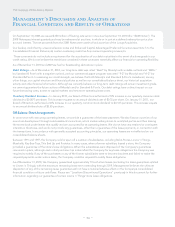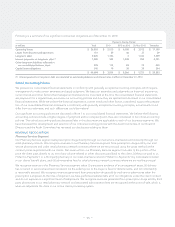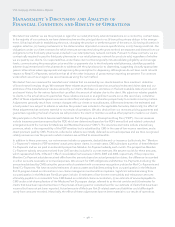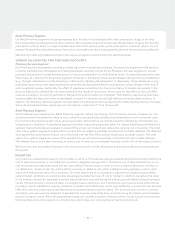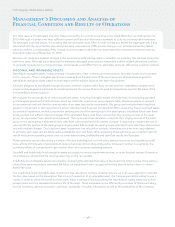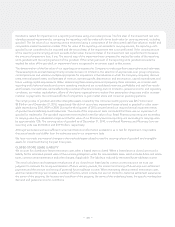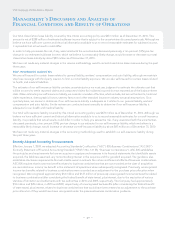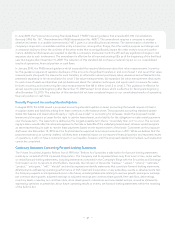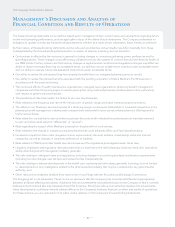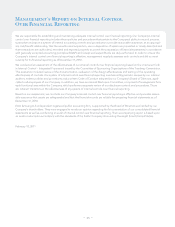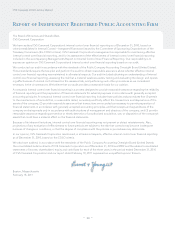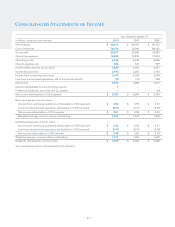CVS 2010 Annual Report Download - page 39
Download and view the complete annual report
Please find page 39 of the 2010 CVS annual report below. You can navigate through the pages in the report by either clicking on the pages listed below, or by using the keyword search tool below to find specific information within the annual report.
Following is a summary of our significant contractual obligations as of December 31, 2010:
Payments Due by Period
in millions Total 2011 2012 to 2013 2014 to 2015 Thereafter
Operating leases $ 26,803 $ 2,013 $ 4,088 $ 3,512 $ 17,190
Leases from discontinued operations 151 29 46 37 39
Long-term debt 9,605 1,103 3 1,100 7,399
Interest payments on long-term debt (1) 7,280 532 1,008 959 4,781
Other long-term liabilities reflected in
our consolidated balance sheet 505 118 83 74 230
Capital lease obligations 340 19 38 39 244
$ 44,684 $ 3,814 $ 5,266 $ 5,721 $ 29,883
(1) Interest payments on long-term debt are calculated on outstanding balances and interest rates in effect on December 31, 2010.
Critical Accounting Policies
We prepare our consolidated financial statements in conformity with generally accepted accounting principles, which require
management to make certain estimates and apply judgment. We base our estimates and judgments on historical experience,
current trends and other factors that management believes to be important at the time the consolidated financial statements
are prepared. On a regular basis, we review our accounting policies and how they are applied and disclosed in our consolidated
financial statements. While we believe the historical experience, current trends and other factors considered, support the prepara-
tion of our consolidated financial statements in conformity with generally accepted accounting principles, actual results could
differ from our estimates, and such differences could be material.
Our significant accounting policies are discussed in Note 1 to our consolidated financial statements. We believe the following
accounting policies include a higher degree of judgment and/or complexity and, thus, are considered to be critical accounting
policies. The critical accounting policies discussed later in this document are applicable to each of our business segments. We
have discussed the development and selection of our critical accounting policies with the Audit Committee of our Board of
Directors and the Audit Committee has reviewed our disclosures relating to them.
REVENUE RECOGNITION
Pharmacy Services Segment
Our Pharmacy Services segment sells prescription drugs directly through our mail service pharmacies and indirectly through our
retail pharmacy network. We recognize revenues in our Pharmacy Services segment from prescription drugs sold by our mail
service pharmacies and under retail pharmacy network contracts where we are the principal using the gross method at the
contract prices negotiated with our clients. Net revenue from our Pharmacy Services segment includes: (i) the portion of the
price the client pays directly to us, net of any volume-related or other discounts paid back to the client, (ii) the price paid to us
(“Mail Co-Payments”) or a third party pharmacy in our retail pharmacy network (“Retail Co-Payments”) by individuals included
in our clients’ benefit plans, and (iii) administrative fees for retail pharmacy network contracts where we are not the principal.
We recognize revenue in the Pharmacy Services segment when: (i) persuasive evidence of an arrangement exists, (ii) delivery
has occurred or services have been rendered, (iii) the seller’s price to the buyer is fixed or determinable, and (iv) collectability
is reasonably assured. We recognize revenues generated from prescription drugs sold by mail service pharmacies when the
prescription is shipped. At the time of shipment, we have performed substantially all of our obligations under the client contract
and do not experience a significant level of reshipments. We recognize revenues generated from prescription drugs sold by third
party pharmacies in our retail pharmacy network and associated administrative fees are recognized at the point-of-sale, which is
when we adjudicate the claim in our online claims processing system.
– 35 –


